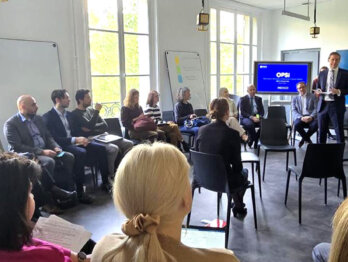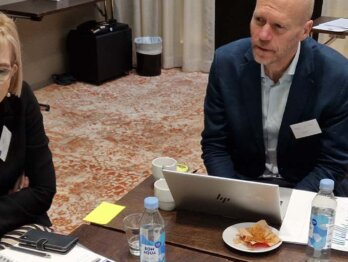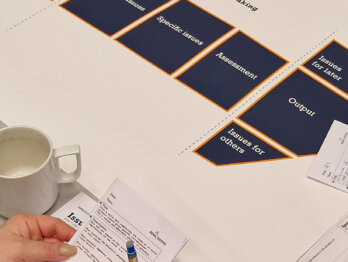What does it take to set up and run government communities of practice for anticipation and foresight? Part 1

This is Part 1 of a bolg series on Government Communities of Practice for Innovation, in which we will explore the existing research and international examples and identify the factors and start-up practices that are likely to catalyse new ideas and embed innovation in organisations and institutions. Read Part 2: “Engage, test, refine – and repeat: Designing and piloting a community of practice in Ireland“.
Government communities of practice are not new. There are countless examples focused on everything from sustainable design practices to the use of specific technology solutions. But what does it take to establish and run them in government, and how are some of them dedicated to supporting anticipatory capacity? In this blog post, we delve into the essential functions of communities of practice in the public sector, examining the purposes and practices of the ones dedicated to anticipation. If you convene or make part of a network or community of practice in anticipation or foresight, we further invite you to share your insights and examples of what it takes to set up and run a successful community through our questionnaire (deadline 29 September, more details below).
Through this, we hope to better understand and share promising methods, activities, and approaches that can be used to establish and run communities of practice for anticipation and strategic foresight.
Calling on all communities!
OPSI invites all government-convened communities of practice in public sector anticipation and foresight topics – whether you are a convener, co-ordinator, facilitator, or member – to share your experiences and insights through this 10-minute questionnaire before the 29 September deadline. We further invite you to add your community to the global crowdsourced map (entries may be reviewed before they appear on the map).
OPSI is committed to recognising the significance of these communities and networks. Insights gathered will culminate in a summary, a public catalogue with short descriptions of the scope, working methods and remit of the identified communities, and potential invitations to their experience with peers. For any enquiries or concerns, please contact Angela Hanson – OPSI Innovation Lead, at [email protected].
What are networks and communities of practice and how have they been used for innovation in government?
Networks, such as innovation networks, tend to be loosely affiliated groups centered on professional interests and traditional forms of knowledge transfer, while communities of practice emphasise shared hands-on challenges and learning through doing, prioritising experiential knowledge. While these are very similar, communities of practice are distinct in that they emphasise the shared commitment and the transfer of practical knowledge.
In the governmental sphere, networks and communities have been powerful resources in driving innovation. They serve purposes such as fostering knowledge sharing, promoting the adoption of novel or best practices, and facilitating co-operation. Communities of practice can counterbalance the slow-moving, often hierarchical structures in governments, improve collective intelligence, and build the long-term practical wisdom of an organisation. These groups are often complementary in purpose but distinct in function from policy and knowledge units or centres and from professional associations, although some may overlap.
For example, in the United Kingdom, the Government Office for Science (GO-Science) seeks to support civil servants in thinking about the future through diverse resources such as training, advisory services, networks, reports on specific issues and technology horizon scanning service. Within this purpose, they use communities of practice to achieve their foresight objectives. They support several cross-government institutional groups, such as the Heads of Horizon Scanning Network, the EmTech Community of Interest, and the Knowledge Mobiliser Network that are instrumental in advancing shared goals.
The purposes of such communities may differ by scale. International communities can shape global norms, facilitate knowledge exchange across borders, and address multi-country challenges, such as the OECD Global Strategic Foresight Community. At national level, communities operating as part of anticipation units, such as Singapore’s Centre for Strategic Futures, often engage in collaborative efforts outside of typical organisational boundaries. Through the Strategic Futures Network, they convene Deputy Secretary officers to discuss emerging trends and implications. The Sandbox Network involves Futures and Strategic Planning officials to share ongoing projects, evaluate ideas and examine collaboration. In Australia, the National Intelligence Community is focused on a specific shared goal within the country: data-driven intelligence to address Australia’s evolving strategic and security environment. However, communities of practice can be as small as a compact, informal group within a single government organisation.
What is different about communities of practice for anticipation and foresight?
Innovative practices, especially strategic foresight, are very practice-based approaches in which experience and knowledge are essential for both specific outcomes and the evolution of the practice itself. This requires a guild or apprenticeship approach versus more traditional knowledge building approaches.
The future is the sum of our individual and collective imaginations. The dialogues among us are opportunities to not only understand our differences and unpack our biases and blind spots, but also to create a space for sense-making, influencing each other’s notions of what is possible and preferrable, and being a place where different sets of knowledge are confronted and contrasted from different expert viewpoints. Such communities can be the vehicle for adopting new and innovative approaches. Concepts, frameworks, and methods are abstract and decontextualise knowledge, whereas “situated knowledge” is embedded in the environment in which it was generated, therefore deeply influenced by the experiences of those who hold it.
This is one reason why simulations, demonstration cases, and communities of practice are so often included in our work on build up anticipatory capabilities in governments. Communities of practice embed knowledge in social and cultural contexts, provide opportunities for sharing alternate knowledge which is often nuanced, not easily articulated, and supportive of tailored and localised problem-solving, and promote the exchange of ideas about the future across disciplines or policy areas. They are therefore an essential component of anticipatory innovation.
What have we learned so far?
As part of our three-year project with the Government of Ireland to build strategic foresight capabilities, we helped to establish a community of practice, bringing together around 1500 officials from across the government to explore future-oriented topics. The lessons from that experience will be the subject of another blog post in this series.
More recently, in project LIMinal, we seek to uncover the value of communities and networks for strategic foresight and anticipation in government, together with the Governments of Lithuania, Italy, and Malta. The project delves into these groups’ organisational dynamics, ecosystem nuances, and maturity attributes to understand the strategies and mechanisms that empower policymakers and foresight practitioners to strengthen their anticipatory capabilities.
Through this work, we noticed that anticipatory and foresight communities have particularly distinct purposes:
- Knowledge sharing and sensemaking: Communities of practice provide a platform for members to share knowledge and develop sensemaking in government anticipation. Sensemaking involves how people gather information, interpret it, and create a coherent understanding of their situation to make sense of the world around them, especially in complex and uncertain situations. This understanding then guides their actions, decisions, and strategies, making it critical for anticipatory innovation.
- Knowledge creation through stakeholder engagement: Communities of practice support knowledge creation and stakeholder engagement on specific futures work. They provide a space for dialogue, problem-solving and collaboration between policymakers, practitioners, and external stakeholders such as academic, civil society, and industry representatives. They can benefit from the proximity and access to “lead users” and those close to the issues, revealing and making tangible the trends and value shifts which may not be detected through traditional means. They can also facilitate opportunity spotting and serve as early warning networks.
- Network building and partnership: Communities of practice foster the development of networks and partnerships among stakeholders involved in anticipatory governance. These networks enable the exchange of information, expertise, and resources, enhancing the capacity to anticipate and respond to future challenges. CoPs provide opportunities for collaboration and joint research strengthening the collective capabilities for anticipatory governance. More unconventional and cross-disciplinary networks and partnerships can promote serendipitous exchanges and provide a safe space to test non-traditional ideas.
- Professional development and capability-building: Communities of practice foster a culture of continuous learning and professional development. Through active participation, policymakers and practitioners have opportunities to enhance specific skills and competencies for government anticipation. This learning contributes to the members’ professional growth and the overall improvement of futures work. This is sometimes supported through e-learning platforms, courses, and programmes, mentoring, certifications, and peer-exchange.
- Advising or review: Some communities of practice can be tapped to provide unofficial review of policies or plans with a future-oriented lens. This can be a much less formal review than work done by legislative review committees (such as futures reviews), while still being quite influential.
To support these different purposes, we are investigating the different governance, strategy, service, operational, and organisational setup options that could be configured to setup, launch, consolidate, and reinvent communities of practice for anticipation and foresight. What we have noticed so far is that some ingredients seem to be particularly important for anticipatory communities of practice:
- Clear direction and leadership: A well-defined purpose, mandate, and strategy that establishes effective leadership and functionality.
- Shared vision and goals: A common vision and objectives that everyone in the community embraces, driving involvement and commitment, including for topics with much uncertainty.
- Unique community engagement: A special community experience that enhances members’ trust and sense of belonging, including safe spaces to explore anticipatory concepts.
- Distinctive initiatives: Purposeful learning and exploration activities and outputs that equip members with practical skills and knowledge for public value creation.
- Constant collaboration and outreach: Continual engagement with partners and broader networks to detect signals and uncover opportunities to inform public policy.
- Effective communication and feedback loops: Devoted efforts to connect and inform, fostering community cohesion and raising awareness in wider circles, distinguishing anticipation as a complementary approach.
We are currently examining specific configurations to develop general guidance, and your input is crucial to further enrich our understanding.
This project is funded by the European Union via the Technical Support Instrument, and implemented by the OECD, in cooperation with the European Commission.











